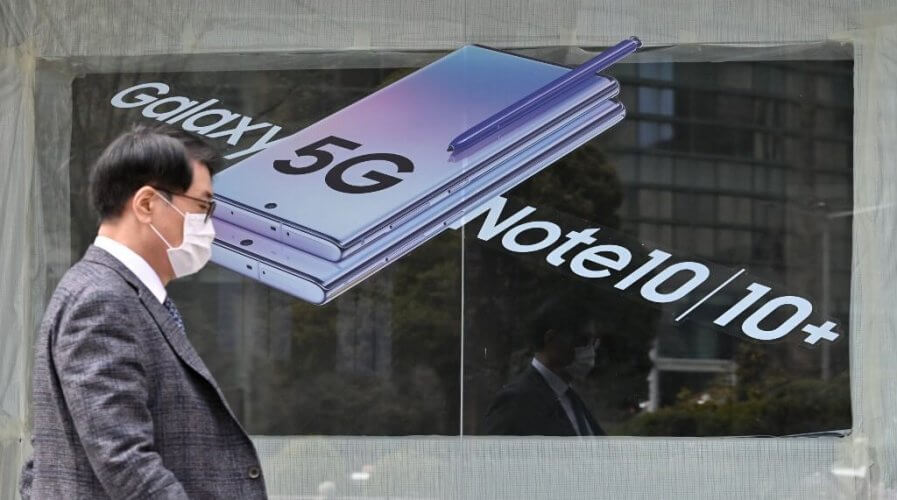
5G connectivity and digital transformation gains like those being seen in South Korea will come to rest of Asia, according to mobility expert. Source: AFP
5G in Asia – rollout plans won’t be affected by COVID-19 says GSMA
- GSMA Head of Asia Pacific shares insights on why COVID-19 will not jeopardize 5G implementation beyond 2020
- Believes coronavirus might “stimulate an adoption of digitization” in enterprises and in nations
- Korea and China lead the way in deployment and usage, but outlook is promising for other parts of Asia
The introduction of next-generation 5G telecommunications and networking infrastructure was well underway in Asia just before the novel coronavirus pandemic fully took root and caused an ongoing disruption to pretty much every sector of business, industry and service.
Operational 5G networks have been implemented in South Korea since 2019 with coverage in 85 cities thus far, while Japan saw commercial 5G being introduced this year. China has the second-highest number of coverage areas with 57 cities, as well as an extensive 5G presence in industrial pilot programs across the country.
This was before COVID-19 began impacting operations in all major industries, and 5G rollouts were no exception to the disruption.
5G technologies were expected to contribute US$2.2 trillion to the global economy by 2034 and to revolutionize the way we connect. Is that still on track to happen?
Tech Wire Asia spoke to Julian Gorman, Head of Asia Pacific for mobility industry specialists GSMA, about the present state of 5G deployment around the region, the benefits that 5G will bring to enterprises and others, and the ripple effects the COVID-19 pandemic will have on 5G implementation going forward.
In its short lifespan, existing 5G networks in the region are already producing some tangible benefits for both service providers and the consumers that use them. In South Korea, there was a significant boost in customers using mobile data after 5G was introduced. This increased the average revenue per user (ARPU) for the telcos that are providing that connectivity.
5G in enterprise applications are also starting to pick up momentum. In China, farmers in Wuzhen are using IoT and 5G to build intelligent glass greenhouses to grow tomatoes.
While manufacturing is the leading sector for enterprise 5G investment, “the more dynamic early applications we’re seeing are not just on the factory floor,” Gorman noted. The technology will have significant impact across the whole supply chain. For example, those same tomatoes in Wuzhen could potentially be tracked from their life on vine, to their journey on pallets to the retailer.
Of course 5G will also play a crucial role in powering our smart city visions and more seamless transportation networks. In Malaysia, a 5G showcase in Langkawi International Airport and a subsequent local pilot project of network usage in January was an indication that providers are looking at how to integrate the technology. In Hong Kong, the island’s international airport will soon be launching its smart airport initiative.
These technologies can even contribute to the recovery of the travel sector. Hong Kong Airport is planning to implement a vast 5G network that will be able to track all of its infrastructure in motion, enabling it to improve service and optimize operations for better efficiency. It’s a concept that could be a “real stimulus”, said Gorman, “to 5G across Asia and also the world when we come out of this supervised lockdown period.”
COVID-19 has curtailed continued 5G deployment plans in the near-term, but that downward trend is unlikely to last. “Most operators who were on track to launch in the next few months expect some sort of delay, partially due to the delays in access and workers being able to move around their countries and install 5G.
“This is a short-term delay to 5G, and in places like Malaysia there are other factors like the new government to consider. [GSMA] still forecasts a user take-up of nearly 1.8 billion people on 5G by 2025, we expect no real long-term impact to 5G rollouts, only short term delays.”
With the impact of the virus leading to an uptick in digitization spend, 5G adoption could actually see a boost from the current circumstances. “There will be a lot more investments being allocated, creating a resilience to networks and ensure a transformation of industries to become more resilient,” Gorman told us.
In a few short months, 2020 has already shown that several major milestones are already within reach — commercial 5G networks were launched in Japan in February, and 5G spectrum bands are being allocated in Malaysia and Singapore to the major telcos.
Exciting applications of 5G are in the offing over the next few years, but maybe just not in 2020. “We were looking forward to Japan showing off 5G capabilities at the Tokyo Olympics, but that has been postponed,” mused Gorman.
READ MORE
- Strategies for Democratizing GenAI
- The criticality of endpoint management in cybersecurity and operations
- Ethical AI: The renewed importance of safeguarding data and customer privacy in Generative AI applications
- How Japan balances AI-driven opportunities with cybersecurity needs
- Deploying SASE: Benchmarking your approach


